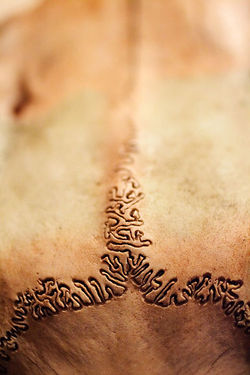Joints - Anatomy & Physiology
Introduction

Joints broadly comprise two categories:
1. Synarthroses- form joints that are relatively rigid.
2. Diarthroses- form joints that are freely movable.
Joint function is to absorb the force of impact, transfer the force via cartilage to bone and to allow a variable degree of movement.
Fibrous Joints
Most fibrous joints occur in the skull, known as sutures. They are key in development as they allow the extension of individual bones during growth. They are gradually eliminated as ossification progresses.
Syndesmoses- Facing areas of two bones, joined by connective tissue ligaments. They have very limited movement allowed, eg. joints of the metacarpus in the horse.
Gomphosis- The attachment of tooth to bone within its socket.
Cartilaginous Joints
Synchondroses, eg. joints between epiphyses and diaphyses of juvenile long bones, disappear on maturity. Permanent synchondroses include the joint between the skull and the hyoid.
Symphysis- Articulating bones are divided by a succession of tissues, with cartilage covering the bones or the tissue between, eg. mandibular, pelvic and vertebral.
Fibrocartilagenous joints- Form a major union between vertebrae, except the first two cervical vertebrae.
Synovial Joints
Articulating joints are separated by a fluid-filled joint cavity, which is bounded by a synovial membrane. A synovial membrane is a pink connective tissue sheet that is vascular and sensitive. It can be unsupported, (membrane may pouch, allowing remote access), resting on an outer fibrous capsule, or separated from the capsule by pads of fat. There is no continuous covering of cells. Where cells exist, they produce lubricant (aminoglycans) of synovial fluid.
Synovial fluid
Synovial fluid nourishes and lubricates the articular cartilage. It is derived from synovial membrane cells and blood plasma. The normal amount in the canine joint is - 0.01 - 1.0 ml. It is possible in equine/bovine joints to find 20-40ml. It is transparent to light yellow (horses) and is usually very thick, due to high hyaluronic acid. :The normal protein is < 25g/l (all species)
- The normal cell count is: large mononuclear cells, <12% neutrophils, <11% lymphocytes.
- Small animals - < 3 x 10e9/L
- Horses - < 0.5 x 10e9/L
- Cows - < 1 x 10e9/L
Often the synovial membrane is reinforced by a fibrous capsule and ligaments. This restricts joint movement and provides stability. It encloses bone and muscle insertions within the joint capsule and is supplied by blood vessels and nerve endings.
Articular cartilage covers the articular surfaces. Usually, this is hyaline, although fibrocartilage or fibrous tissue can substitute. Articular cartilage is avascular and insensitive, nutrients enter via diffusion from the synovial fluid and nearby vessels (adjoining tissue and marrow cavities).
Some joints possess intracapsular discs or menisci to provide congruence and enable complicated movements, eg. temperomandibular joint, paired menisci of the stifle joint. There is limited response to injury and little repair capacity.
Joint Movements
1. Translation Flat surfaces slide against each other, producing no change in orientation of their bodies
2. Rotation - Moving bone turns on an axis perpendicular to articulation
3. Swing - Moving bone turns on an axis parallel to articulation
4. Flexion (aka palmar flexion) - Angle between two segments of a limb is reduced
5. Extension - Angle between two segments of a limb is increased
6. Overextension (aka dorsal flexion) - eg. posture of equine fetlock standing at rest
7. Adduction - Pendular movement toward the median plane
8. Abduction - Pendular movement away from the median plane
9. Circumduction Combination of flexion and extension that allows a limb to create a circular movement
Types of Joints
1. Plane Joint describes translational movement; in reality, nonexistent, as all articular surfaces are curved
2. Hinge Joint movement allowed in one plane only, inhibited by collateral ligaments and/or bony protuberances (eg. elbow joint)
3. Pivot Joint comprises a peg fitted with a ring, movement occurs about the long axis of the peg (eg. radioulnar joint)
4. Condylar Joint knuckle-shaped condyles vary in distance from one another allowing uniaxial movement with limited rotation (eg.femorotibial joint)
5. Ellipsoidal Joint ovoid convex articulation, allows movement in two planes at right angles with limited rotation (eg. radiocarpal joint)
6. Saddle Joint also biaxial with a greater scope for rotation
7. Spheroidal Joint (aka ball-and-socket) multiaxial movement allows for rotational movement in several planes (eg hip joint)
Joint Formation
Joints begin to form as the mesenchyme is condensing. Joint-forming cells develop different characteristics to cartilage precursors, they are flat and densely packed. The region where these joint-forming cells exist is called the "interzone". There are three layers in the interzone, a middle layer of low density with regions of high density either side. The high density regions form cartilage. The middle layer is eliminated by cell death, forming the joint space.
Links
Click here for information on joint pathology
Error in widget FBRecommend: unable to write file /var/www/wikivet.net/extensions/Widgets/compiled_templates/wrt69632db1e993f2_47102316 Error in widget google+: unable to write file /var/www/wikivet.net/extensions/Widgets/compiled_templates/wrt69632db1efa433_76185624 Error in widget TwitterTweet: unable to write file /var/www/wikivet.net/extensions/Widgets/compiled_templates/wrt69632db200e6e6_04096483
|
| WikiVet® Introduction - Help WikiVet - Report a Problem |


